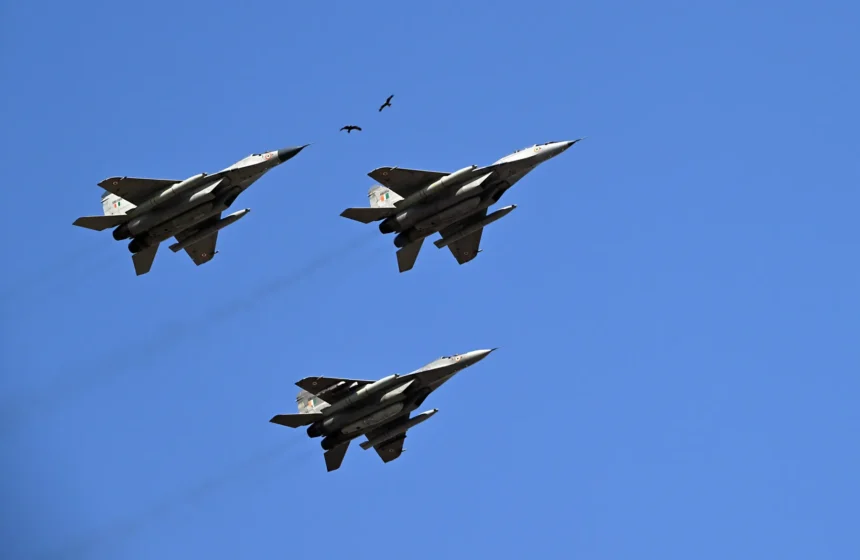The Claim That Shook Diplomacy — Trump’s Controversial Statement and Its Immediate Fallout
Former U.S. President Donald Trump is no stranger to making bold, headline-grabbing statements. But when, in a high-profile interview, he recently claimed that “five fighter jets were downed” amid the ongoing India-Pakistan military tensions, global diplomatic and defense circles were sent into a frenzy. This comment — made without corroborating evidence from either country — sparked debates not only about the veracity of the information but also about Trump’s ongoing influence over international discourse and the strategic implications for South Asia.
The statement comes at a time when India and Pakistan are already engaged in a tense military standoff that has captured global attention. According to Trump, the downed aircraft were “likely the result of direct confrontations,” and he suggested that U.S. intelligence had provided “early warnings to prevent broader escalation.” While officials from both New Delhi and Islamabad have remained largely silent on the specifics, both countries did confirm heightened aerial activity along the Line of Control (LoC) and reinforced defense postures.
Strategic Background: A History of Flare-Ups
The India-Pakistan relationship has been characterized by decades of hostility, three full-scale wars, and countless skirmishes — particularly over the disputed region of Jammu and Kashmir. In recent years, the growing strength of both countries’ air forces, coupled with political nationalism and nuclear capabilities, has made any aerial engagement a cause for international concern.
Tensions flared again in mid-2025 after a cross-border militant attack in Jammu’s Poonch district, which India blamed on Pakistan-backed groups. In response, India launched “precision counter-insurgency operations” near the LoC. Pakistan countered with what it termed “defensive mobilization.” A few days later, unverified footage began circulating on social media showing aerial dogfights and large plumes of smoke rising from mountain ridges — fueling speculation of air-to-air engagements.
Trump’s comments added fuel to this already volatile scenario.
The Global Reaction to Trump’s Statement
Within hours of Trump’s interview airing on a major American news network, foreign policy analysts, media houses, and diplomats scrambled to verify the claims. The Pentagon declined to comment, while White House spokespersons walked a tightrope — stating that the U.S. “remains closely engaged in monitoring South Asia” but would “not confirm operational intelligence.”
India’s Ministry of External Affairs (MEA) issued a curt statement, saying, “Statements made by individuals outside the government apparatus should not be taken as indicative of the situation on the ground.” Pakistan’s Foreign Ministry, however, seized the opportunity to criticize India, suggesting that “the international community is now aware of the dangers posed by Indian aggression.”
The United Nations also issued a brief statement urging “restraint and de-escalation by all parties,” while Russia and China called for bilateral dialogue.
Dissecting the Numbers: Were Five Jets Really Downed?
Perhaps the most contentious aspect of Trump’s claim lies in the exact figure he offered — five fighter jets allegedly shot down. Defense experts are divided. Some argue that such a figure is unusually high for any short-term aerial conflict and would likely result in immediate announcements, especially from India, which often publicizes successful military actions for strategic messaging. Others suggest that both countries may be withholding information to prevent panic or premature escalation.
Satellite images analyzed by independent war tracking agencies have shown what appear to be two crash sites near the LoC, but no conclusive evidence has emerged to substantiate the claim of five jets being downed.
This lack of clarity opens the door to questions: Was Trump exaggerating for political impact? Or was he inadvertently revealing classified intelligence?
As Donald Trump’s explosive assertion reverberated globally, media organizations, geopolitical analysts, and intelligence circles moved quickly to assess both the credibility and potential consequences of the statement. The former U.S. president’s claim — that five fighter jets were downed during the India-Pakistan standoff — had not only taken two nuclear-armed neighbors by surprise but also placed international stakeholders on edge, forcing governments and institutions to reassess the current balance of power and readiness in South Asia.
Media Scramble: Verifying What Wasn’t Public Yet
Within hours of Trump’s interview, major global news outlets such as CNN, BBC, Al Jazeera, The Times of India, and Dawn in Pakistan initiated live coverage and expert panels to discuss the bombshell revelation. Journalists contacted military spokespersons, former intelligence officials, and satellite image analysts, yet confirmation remained elusive.
Several major defense and open-source intelligence (OSINT) accounts on X (formerly Twitter) and Telegram began disseminating satellite footage that they claimed showed air activity, heat signatures from missile launches, and possible debris fields. Some OSINT channels geolocated the activity to contested border zones near Poonch and Rajouri in Indian-administered Kashmir. However, independent verification remained difficult, and neither New Delhi nor Islamabad released detailed air force casualty reports.
The Indian media, particularly outlets like Republic TV, Times Now, and India Today, carried mixed tones. Some took Trump’s statement as an acknowledgment of India’s operational superiority, suggesting the downed aircraft could have belonged to Pakistan. Others expressed skepticism, emphasizing India’s disciplined handling of cross-border incidents without political showboating.
In contrast, the Pakistani media framed the comment as indicative of escalating Indian aggression. Geo News and ARY speculated that the alleged air losses could be part of a retaliatory air operation by Pakistan in response to Indian drone incursions or artillery fire near civilian settlements. Yet again, facts remained tightly controlled by the state.
Intelligence Agencies Enter Silent Coordination
In the aftermath of the media whirlwind, the focus shifted to the closed-door corridors of intelligence agencies in Washington, London, Moscow, and Beijing. Trump, as a former U.S. President, still has informal access to certain briefings, especially when maintained through think tanks, former aides, or diplomatic contacts. This led many within the intelligence community to privately question whether Trump had accessed restricted information and disclosed it—intentionally or recklessly—in a political context.
Analysts from the CIA and NSA reportedly flagged the remark internally, according to leaks from Capitol Hill sources, sparking a quiet inter-agency review. In London, MI6 remained on standby, as the UK has historically played a mediating role during India-Pakistan crises. Meanwhile, Indian intelligence agencies, including RAW and the Defence Intelligence Agency (DIA), ramped up internal coordination, reportedly placing surveillance assets near high-risk zones and conducting internal audits to ensure no critical information had been compromised.
China’s intelligence community, which maintains deep strategic interests in both Pakistan and India, notably refrained from public comment. Behind the scenes, Chinese analysts reportedly viewed Trump’s remarks as a destabilizing factor, one that could potentially derail Beijing’s ambitions for cross-border trade and infrastructure diplomacy under the China-Pakistan Economic Corridor (CPEC).
Political Exploitation and Strategic Calculations
Trump’s claim did more than rattle intelligence desks. It also provided political ammunition across the ideological spectrum. In India, BJP supporters amplified Trump’s statement as a “global acknowledgment” of India’s military supremacy, often ignoring the ambiguity of the claim. Nationalist social media influencers circulated digitally altered images and unverified videos portraying Pakistan’s supposed air losses.
In Pakistan, however, the political establishment tried to use the moment to underscore the urgency of international intervention. Members of Prime Minister Shehbaz Sharif’s cabinet warned that the region was “one provocation away from nuclear fallout” and urged the United Nations to investigate what they called “India’s expansionist provocations.”
Even in the U.S., the political ripple was undeniable. Democratic lawmakers criticized Trump for “destabilizing fragile regions” with speculative remarks, while Trump-aligned Republicans defended the former president, arguing he had merely exposed truths the Biden administration was unwilling to confront.
Strategic Timelines: Was There a Covert Skirmish?
The biggest question that emerged was whether a covert or unreported aerial skirmish had already occurred, with both sides suppressing details to avoid triggering full-scale conflict. Defense experts drew comparisons with the 2019 Balakot strike and the subsequent dogfight in which an Indian MiG-21 was shot down and its pilot, Wing Commander Abhinandan Varthaman, captured and later released by Pakistan. That incident, initially cloaked in media fog, had eventually been confirmed under global pressure.
Could a similar event have occurred again in 2025?
If five aircraft were indeed lost, as Trump claimed, it would likely involve advanced multirole fighters like India’s Rafales or Pakistan’s JF-17s or F-16s. Such losses would be impossible to hide for long given international radar tracking, visual sightings from civilians, and the massive logistical chain behind every fighter sortie.
Yet, despite mounting speculation, both India and Pakistan continued to neither confirm nor deny the claim — a silence that speaks volumes in the high-stakes theater of military diplomacy.
The allegations made by former U.S. President Donald Trump regarding the downing of five jets in the India-Pakistan conflict have reopened a long-feared question in global diplomacy: How close are South Asia’s nuclear powers to actual war? While the military posturing and nationalist fervor dominate the headlines, underneath lies a deep-set doctrine of restraint tempered by decades of experience, the fear of mutual destruction, and the grim arithmetic of nuclear escalation.
India’s Military Doctrine: A Shift from Restraint to Pre-Emption
India’s strategic doctrine has long emphasized credible deterrence with an orientation toward defensive postures, especially in nuclear scenarios. However, after the 2008 Mumbai attacks and particularly post the 2016 Uri terror strike, New Delhi began pivoting to a more proactive approach. The term surgical strike entered public consciousness. And by 2019, following the Pulwama suicide bombing and the Balakot airstrikes that followed, the transformation in India’s strategic playbook was evident.
Post-2019, India’s policy showed a clear evolution from strategic restraint to active deterrence. The induction of French-made Rafale jets, modernization of the Integrated Battle Groups (IBGs), and strengthening of satellite and radar infrastructure created the backbone for an agile and tech-driven military force. If Trump’s statement carries any truth, it may be a result of a covert pre-emptive or retaliatory air operation executed under this recalibrated doctrine.
Pakistan’s Military Posture: Asymmetric Readiness and Strategic Depth
Pakistan, by contrast, has relied heavily on maintaining strategic ambiguity. While India operates with overt displays of force, Pakistan has often leveraged its geographic depth, asymmetric warfare capabilities, and highly mobile air defense systems to maintain unpredictability.
Its fleet of Chinese JF-17 Thunder fighters, U.S.-supplied F-16s, and indigenous upgrades to surveillance and radar defense have created a responsive, if limited, air superiority mechanism. Additionally, its conventional air strategy is integrated with its full-spectrum nuclear doctrine, which means Pakistan doesn’t rule out nuclear weapon use even in response to large-scale conventional attacks.
This asymmetry, where Pakistan seeks to offset its inferior conventional capability with low-threshold nuclear deterrence, is the core of its strategic mindset. Any credible report of multiple aircraft losses—if they are Pakistani—would therefore mark a critical breach of Pakistan’s internal escalation ladder.
The Ever-Present Nuclear Threat: Deterrence or Illusion?
With both nations publicly committed to a “No First Use” (NFU) doctrine—though India has hinted at doctrinal flexibility—the Trump revelation raised chilling concerns. Five fighter jets downed in combat would represent one of the most serious aerial confrontations since the 1971 war or the 2019 Balakot skirmish. And the threshold for nuclear posturing begins to flicker dangerously close with every such incident.
South Asia’s nuclear architecture, despite its publicly stated restraint, remains opaque and highly fragile. Neither India nor Pakistan has sophisticated early warning systems on par with the U.S. or Russia. There is no equivalent of the Cold War–era “red phone” or open hotline that can de-escalate rapidly in real time. Miscalculation, miscommunication, or political opportunism could easily trigger unintended consequences.
In this context, Trump’s unsanctioned claim did more than reveal military data — it risked disturbing a delicate balance where each nation walks a razor’s edge between chest-thumping nationalism and mutual annihilation.
Deconstructing the Possibility: Could Five Fighter Jets Really Be Downed Without Public Notice?
Critics of Trump’s claim have pointed out a key logistical and political challenge: how could the downing of five aircraft — whether Indian or Pakistani — go unnoticed in today’s hyperconnected world?
Several possible answers exist:
- Staged Escalation Under Controlled Secrecy
It’s possible both countries agreed, directly or via backchannels, to downplay or entirely suppress a limited skirmish to avoid provoking full-scale escalation. This wouldn’t be unprecedented. In 1999’s Kargil War, international media coverage outpaced official military disclosures. - Electronic Warfare & Stealth Engagement
With modern warfare increasingly dominated by low-visibility operations — using drones, stealth aircraft, and electronic warfare — an air encounter may not leave behind the kind of visual signatures expected in past wars. Downed jets in rugged terrain may remain unrecovered or deliberately obscured. - Third-Party Involvement in Damage Assessment
Trump’s intelligence, if accurate, could have originated from NATO satellite data, SIGINT (signal intelligence), or Israeli surveillance assets — all of which monitor the region. Their findings may never reach public domain unless political leadership leaks it — as Trump may have done. - Domestic Political Optics
Admitting jet losses in peacetime would be politically damaging to either government. For India, it could disrupt narratives of aerial dominance. For Pakistan, it could provoke public backlash against perceived military weakness. Therefore, silence or misinformation may be strategic rather than deceptive.
Diplomatic Fallout: Will Trump’s Statement Force International Mediation?
Beyond the regional powder keg, Trump’s remarks have the potential to reshape international diplomacy on South Asia. The U.S. State Department has so far not commented on his statement. But behind closed doors, diplomatic missions in New Delhi and Islamabad are believed to be actively gathering clarifications.
India and Pakistan are not signatories to the Treaty on the Prohibition of Nuclear Weapons, and their bilateral tensions have long defied mediation. Yet global institutions — from the United Nations to the International Crisis Group — might seize this moment to push for structured talks on air-space control, cross-border hotlines, and satellite monitoring agreements.
China and Russia, key players in the Shanghai Cooperation Organisation (SCO), also have stakes in regional peace. Their silence may eventually break into quiet diplomacy if cross-border engagements increase.
While global media fixates on Donald Trump’s claims, fighter jet numbers, and geopolitical consequences, the true heartbeat of any conflict lies not in radar logs or diplomatic cables — but in the stories of ordinary people whose lives unravel on either side of the Line of Control (LoC). As India and Pakistan move troops, adjust air defense postures, and amplify rhetoric, the human cost of this standoff quietly accumulates in the hinterlands of Kashmir, Punjab, and Sindh.
Kashmir: A Region Under Perpetual Siege
In the Indian-administered region of Jammu & Kashmir, every military escalation — actual or perceived — translates into curfews, power cuts, communication blackouts, and lockdowns. Reports from towns like Poonch, Kupwara, and Baramulla indicate heightened military movement since the first murmurs of the alleged air conflict. Schools remain closed in many areas near the LoC, and families are relocating to underground bunkers or migrating temporarily to safer towns.
“The sounds of jets at night — it’s become a new kind of terror,” says Aamir Lone, a teacher in Uri. “Even if nothing is shown on the news, we know what’s happening from the air.”
Markets in border villages remain half-stocked. Medical clinics, already short-staffed post-pandemic, struggle to function during army movement restrictions. Civilian life here operates under invisible crosshairs — where a wrong turn on a hillside road or a misheard command from a soldier can have fatal consequences.
In Pakistan-Administered Azad Kashmir and Punjab: Fear and Familiarity
Across the border, in Pakistan’s Mirpur and Bhimber districts, similar patterns emerge. Families have begun rationing food, storing water, and sending children to live with relatives deeper inland. “This isn’t the first time we’ve lived like this,” says Noreen Shafiq, a homemaker in Kotli. “But we thought we were past it after Kartarpur and all those peace gestures.”
Tragically, the normalization of militarized life — sirens, air-raid drills, and crossfire anxiety — has become routine. In border towns of Pakistan’s Punjab province like Sialkot and Narowal, local government authorities have advised people to avoid travel during dusk and dawn — hours when aerial surveillance activity is highest.
Civil society organizations, including Edhi Foundation and Al-Khidmat, are quietly mobilizing relief volunteers in case of mass displacement. While official media maintains calm, local WhatsApp groups are flooded with unverified videos of fighter jets, alleged airstrikes, and citizen commentaries.
Media Manipulation & Misinformation: A New Warzone
In the information age, war is no longer fought solely on the ground or in the skies. Twitter, Facebook, Telegram, and YouTube have become frontline tools in shaping perception, sowing division, and bolstering narratives. Both Indian and Pakistani online ecosystems are flooded with conflicting claims: images of jet debris, thermal satellite shots, intercepted messages — most of which remain unverified.
Pro-government influencers on both sides are trending hashtags like #SurgicalStrike3 and #PakistanRetaliates, triggering jingoistic fervor and stifling nuanced voices. Meanwhile, independent journalists are either censored or dismissed as “anti-national” or “agents.”
This info-war has psychological consequences. Misinformation isn’t just disorienting — it can drive panic buying, inter-community hatred, and mob violence. Experts in conflict resolution worry that an unverified “jet downing” story, amplified improperly, could provoke real-world bloodshed.
Border Economies at Breaking Point
Entire ecosystems depend on the porous, albeit tense, cross-border dynamics — from border trade at Wagah and Attari to informal agricultural exchange near the Rann of Kutch. Military tension hits these micro-economies the hardest.
Truck drivers who operate near border checkposts have been advised to halt routes. Local tourism in Kashmir and parts of Punjab has dropped to near-zero. Cross-border farming near Suchetgarh and Ganda Singh Wala — areas often hit by artillery skirmishes — has been abandoned mid-season. The economic ripple effects of this airspace tension could impact lakhs of families, most of whom live below the poverty line.
“Even if there’s no full war, these flashpoints ruin everything,” explains Iqbal Singh, a farmer in India’s Pathankot region. “Crop cycles get disrupted. Insurance claims don’t come through. The land becomes risky, and people migrate.”
Mental Health Crisis in Conflict Zones
Years of unresolved tension have left deep psychological scars among the youth, especially in Jammu & Kashmir. Children in border towns draw tanks instead of trees, play war games instead of cricket, and normalize the sound of sirens and bullets.
In a revealing report by Médecins Sans Frontières (MSF), over 50% of adults in Kashmir showed symptoms of PTSD, anxiety, or clinical depression — figures mirrored in Pakistan-administered zones. Yet, both governments spend little on trauma counselling or conflict psychology.
The reactivation of military engagement, as suggested by Trump’s remarks, could further deepen these wounds. The silent suffering of these civilians — trapped between nationalism and nukes — often remains unrecorded in diplomatic cables or global headlines.
As former U.S. President Donald Trump’s explosive claim—that five fighter jets were downed in the escalating India-Pakistan conflict—reverberated across global media, the international community began to stir. While both South Asian rivals maintained a tightly controlled narrative, the geopolitical chessboard shifted as key powers responded, recalibrated, and, in some cases, intervened behind the scenes. The story was no longer just about India and Pakistan—it was about how the world’s military and diplomatic giants would manage a high-risk flashpoint in one of the most volatile nuclear zones on the planet.
The United States: Between Trump’s Words and Biden’s Silence
Donald Trump’s claim, issued during a rally-turned-security briefing in Ohio, left the Biden administration scrambling for damage control. As Trump stated that “five fighter jets have been shot down in the skies over South Asia,” reporters demanded clarity from the State Department. U.S. Secretary of State Antony Blinken issued a terse response: “The situation between India and Pakistan is being monitored very closely. The U.S. continues to urge both nations to exercise strategic restraint and open communication channels.”
Behind closed doors, however, Washington was abuzz with emergency briefings. Satellite surveillance data from U.S. military bases in Diego Garcia and the Middle East were reviewed. According to insiders at the Pentagon, while movement was detected near the LoC and key airbases like Ambala, Pathankot, and PAF Mushaf, there was no official confirmation of downed aircraft.
Meanwhile, Trump’s remark is seen as a political maneuver designed to project global awareness and leadership, regardless of its factual basis. His reemergence as a force in American foreign discourse—albeit unofficial—has already created friction within U.S. intelligence circles.
China: The Calculated Observer
China, which shares borders with both India and Pakistan and has strategic stakes in the region, adopted a cautious yet assertive posture. The Chinese Foreign Ministry issued a statement saying:
“We urge restraint from all parties involved. China supports peace and stability in South Asia and advocates dialogue through diplomatic channels.”
While Beijing’s words echoed neutrality, its actions told a different story. Troop reinforcements near Ladakh and Aksai Chin were reported by Indian satellite surveillance, suggesting that China was preparing for contingencies should the India-Pakistan conflict widen or spill across regions where Chinese interests are involved—especially given the China–Pakistan Economic Corridor (CPEC).
Intelligence also points to stepped-up drone surveillance by China in the Gilgit-Baltistan region, potentially to monitor both Indian movements and Pakistan’s preparedness. China’s role as a ‘silent balancer’ is reaffirmed—non-interventionist in tone, but highly active in strategy.
Russia: The Arms Dealer Turned Mediator
Russia finds itself in a delicate position. As one of India’s historic defense partners and Pakistan’s newer arms supplier, Moscow has been steadily developing ties with both countries. The Kremlin expressed “deep concern” over Trump’s claims and the rising tension.
President Vladimir Putin’s office offered to “facilitate backchannel dialogue,” highlighting Russia’s long-term interest in maintaining regional equilibrium. There is speculation that Russian intelligence was the first to debunk Trump’s claim internally, citing lack of radar confirmation or crash-site data. However, Russia is walking a diplomatic tightrope—eager to appear neutral while shielding India from excessive Western criticism.
Analysts believe that Russia may act as a covert crisis mediator, especially given its recent experience navigating complex rivalries in Ukraine, Syria, and the Caucasus.
The Gulf States: Alarmed, Yet Cautious
Countries like the United Arab Emirates, Saudi Arabia, and Qatar have deep economic ties with both India and Pakistan. Following Trump’s claim, Gulf states called for calm but refrained from specific remarks on the airspace incident. Their focus, as always, remains on protecting remittance corridors and migrant populations.
With millions of Indian and Pakistani workers in the Gulf, any escalation threatens regional labor markets and could trigger economic instability. In response, UAE officials initiated diplomatic calls to both New Delhi and Islamabad urging bilateral dialogue.
However, analysts suggest that behind the scenes, Gulf intelligence networks are preparing for refugee management, financial disruptions, and diplomatic fallout should the conflict intensify.
The United Nations: Repeating the Script
The United Nations Secretary-General António Guterres issued the familiar refrain: “Both India and Pakistan must avoid any further escalation and resolve their differences through peaceful dialogue.” The UN, lacking enforcement power in bilateral military skirmishes, has become a symbolic rather than strategic voice.
However, key UN Security Council members did privately discuss the risk of escalation under “Any Other Business,” especially after Trump’s statement. There was no resolution passed, but diplomatic missions to Geneva and New York were activated by both South Asian countries to shape the narrative.
Meanwhile, UN observers in Kashmir under the United Nations Military Observer Group in India and Pakistan (UNMOGIP) have increased activity, though their limited mandate has historically made little impact on real-time deterrence.
The European Union: Focused on Trade, Not War
European nations, preoccupied with internal politics and the Russia-Ukraine conflict, reacted with muted concern. The EU’s External Action Service stated it was “monitoring developments” and urged “maximum restraint.” NATO, meanwhile, had no official role or involvement.
However, countries like France and the UK—given their diaspora populations and past colonial links—have ramped up consular outreach to citizens in both countries, advising caution and travel restrictions near border regions.
Geopolitical Risk Index: Markets Take Notice
The moment Trump made his statement, stock markets in India and Pakistan saw knee-jerk reactions. The BSE Sensex and Nifty dropped by over 400 points before stabilizing, while the Karachi Stock Exchange also took a brief hit. Global defense investors began tracking supply-chain vulnerabilities in the region, while oil markets remained volatile due to fears of broader regional spillover.
Gold prices spiked globally—reflecting investor flight to safe-haven assets—and insurance premiums on aviation companies operating in South Asia rose sharply.








